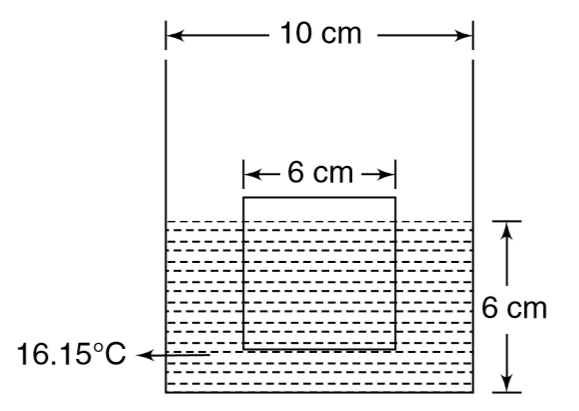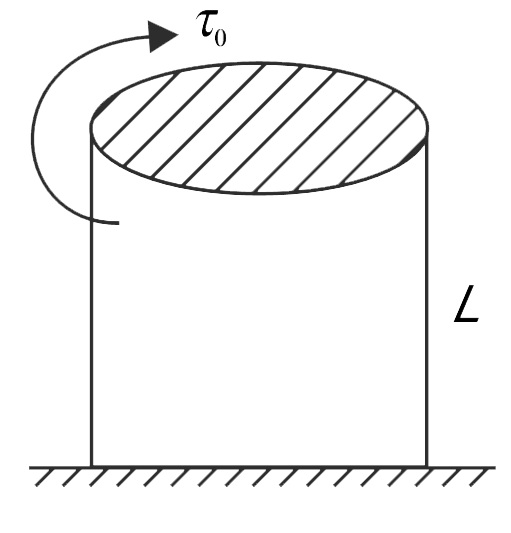An electric kettle is filled with 1.3kg of water at 20∘C. The power of the heating coil of the kettle is 2.0 KW. After switching it on the water begins to boil in 220s . If the kettle was kept on for a further interval of Δt it was observed that only 200g water remained in the kettle and remaining water vaporized (the vapor is allowed to escape through a small vent). The specific latent heat of vaporization of water at 100∘C (boiling point) is L=2.26KJ/g. Calculate the specific heat capacity of water and the interval Δt. Assume that heat supplied by the heater is completely absorbed by the water.
The correct Answer is:s=4.23kJKg−1.∘C−1; Δt=1250s
Step by step video, text & image solution for An electric kettle is filled with 1.3 kg of water at 20^(@)C. The power of the heating coil of the kettle is 2.0 KW. After switching it on the water begins to boil in 220s . If the kettle was kept on for a further interval of Delta t it was observed that only 200g water remained in the kettle and remaining water vaporized (the vapor is allowed to escape through a small vent). The specific latent heat of vaporization of water at 100^(@)C (boiling point) is L = 2.26 KJ//g. Calculate the specific heat capacity of water and the interval Delta t. Assume that heat supplied by the heater is completely absorbed by the water. by Physics experts to help you in doubts & scoring excellent marks in Class 11 exams.
Updated on:21/07/2023Topper's Solved these Questions
Similar Questions
A container has a square cross-section of 10cm×10cm. A cubical ice block of side length 6 cm is floating in water in the container. Water level in the container is 6 cm high. The ice block is at a temperature of 0∘C and the water is at 16.15∘C. Assume that heat exchange take place between the ice block and water only. What length of ice block will remain submerged in water when the system reaches thermal equilibrium? Assume that the ice block maintains its cubical shape as it melts. Take - density of ice =0.9g/cc, density of water = 1.0g/cc
Specific heat capacity of water =1calg−1.∘C−1, Specific latent heat of fusion of ice =80calg−1

View SolutionA copper calorimeter has mass of 180 g and contains 450 g of water and 50 g of ice, all at 0∘C. Dry steam is passed into the calorimeter until a certain temperature (θ) is reached. The mass of the calorimeter and its contents at the end of the experiment increased by 25 g. Assume no heat loss to the surrounding and take specific heat capacities of water and copper to be 4200Jkg−1K−1 and 390Jkg−1K−1, respectively. Take specific latent heat of vaporization of water to be 3.36×105Jkg−1 and 2.26×106Jkg−1 respectively.
(a) Find the final temperature θ
(b) If steam enters into the system at a steady rate of 5g−1min, plot the variation of temperature of the system till final temperature θ is attained.
View SolutionIn an experiment mileage of a car was measured to be 24kmpl (Kilometer per liter of fuel consumed). After the experiment it was found that 4% of the fuel used during the experiment was leaked through a small hole in the tank. Calculate the actual mileage of the car after the tank was repaired.
View SolutionA metal cylinder of length L and radius R is fixed rigidly to ground with its axis vertical. A twisting torque τ0 is applied along the circumference at the top of the cylinder. This causes an angular twist of θ0 (rad) in the top surface. Calculate the shear modulus of elasticity (η) of the material of the cylinder.

View SolutionAn electric kettle has two heating coils. when one coil is used, water in the kettle boils in 5 minutes, while when second coil is used, same water boils in 10 minutes. If the two coils, connected in parallel are used simultaneously.the same water will boil in time
View SolutionAn electric kettle has two coils. When one of these is switched on, the water in the kettle boils in 6 minutes. When the other coil is switched on, the water boils in 3 minutes. If the two coils are connected in series, find the time taken to boil the water in the kettle.
View SolutionIn an electric kettle, water boils in 10 minutes after the kettle is switched on. With the same supply voltage if the water is to be boiled in 8 minutes, should the length of the heating elemnet be increased or decreased ? Explain .
View SolutionAn electric kettle was marked 500W,220V and was found to raise 1 kg of water to 20∘ to the boiling point in 20 minutes. Calculate the heat efficiency of the kettle. Sp. Heat of water =4200Jkg−1K−1.
View SolutionAn electric kettle of 1200W has 1 kg water at 20^@C . The water equivalent of the kettle is 500g . The time required to heat water from 20^(@) to 100^(@)C will be (specific heat of water = 4200 J//kg^(@)C) .
View Solution1 kW की एक विद्युत केतली में 20∘C पर 1 kg पानी है। पानी को क्वथनांक तक गर्म करने के लिए आवश्यक समय की गणना करे। (केतली का जल -तुल्यांक =0.5 kg)
View Solution1 विद्युत् केतली को शक्ति 2.1 किलोवाट है। इसमें 20∘C पर 1.5 किग्रा पानी भरा है। क्वथनांक तक पहुँचने मे लगा समय होगा :
View SolutionWater boils in an electric kettle in 10 minutes after being switched on .How will you modify the heating coil to boil water is 5 minutes using the same source of power ?
View SolutionAn electric kettle has two coils when one of the coils is switched on, the kettle can boil water inside it in 12 minutes to boil. When the coil are connected in series
View SolutionAn electric kettle has two windings. When one of them is switched on, the water in the kettle begins to boil in 15 minutes, and when the other is switched on it takes 30 minutes for water to boil. If the two windings are joined in series and switched on, water in the kettle begin to boil after time: (in minutes) [Assume that the kettle loses no heat to the surroundings]
View SolutionAn electric kettle contains 1.5 kg of water of 100∘C and is poweredby a 2.0 kW electric element. If the thermostat of the kettle fails to operate, approximately how long will thekettle take to boil dry? (Take the specific latent heat of vaporisation of water as 2000kJkg−1)
View Solution